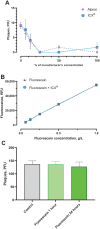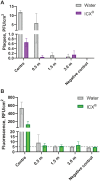Waterline Disinfectants Reduce Dental Bioaerosols: A Multitracer Validation
- PMID: 35492016
- PMCID: PMC9397394
- DOI: 10.1177/00220345221093522
Waterline Disinfectants Reduce Dental Bioaerosols: A Multitracer Validation
Abstract
Oral microbes are dispersed during dental treatment and reduction methods have been proposed, but dental unit waterline (DUWL) disinfectants have received little attention; specifically, the effect on viruses has not been studied. This study aims to 1) investigate the effect of DUWL disinfectants on viral dispersion in dental bioaerosols and 2) establish a dual-tracer system using live bacteriophage and fluorescein supported by optical particle measurement. Bacteriophage MS2 was used as a viral tracer and fluorescein as a fluorescent tracer. Validation experiments were conducted to exclude interference of one tracer with the other or of DUWL disinfectants on detection methods. Simulated "saliva" containing the tracers was infused into the mouth of a dental mannequin during 10-min dental procedures with an air turbine handpiece (n = 3 replicates). Aerosols and droplets were sampled in an enclosed dental operatory using air samplers and settlement onto sterile filter papers. Bacteriophage was quantified using plaque assays and reverse transcription quantitative polymerase chain reaction (RT-qPCR). Fluorescein was quantified fluorometrically. The effect of DUWL disinfectants on total aerosol concentration was assessed in separate experiments using an optical particle counter. DUWL disinfectants reduced bacteriophage viability, and interference between tracers was not observed. In simulated clinical procedures, the disinfectant ICX reduced bacteriophage detection substantially (P < 0.001; 2-way analysis of variance). MS2 RNA was detected in all experimental samples but not negative controls. Samples positive on RT-qPCR but not plaque assays may indicate that virions at distant sites are nonviable. Fluorescein tracer showed good agreement with the bacteriophage tracer. DUWL disinfectants designed for continuous presence in irrigants reduce the dispersion of viable virus in dental bioaerosols during simulated procedures. Their use may therefore be important for routine infection control and as a mitigation factor during infectious disease outbreaks. Future studies should explore this using a range of viruses and other microbes.
Keywords: aerosol-generating procedure; dental disinfectants; dental facilities; dental high-speed equipment; infection control; viral plaque assay.
Conflict of interest statement
Figures




Similar articles
-
Metataxonomics study of dental bioaerosols affected by waterline disinfection.BMC Oral Health. 2024 Dec 31;24(1):1575. doi: 10.1186/s12903-024-05304-4. BMC Oral Health. 2024. PMID: 39741231 Free PMC article.
-
Local Exhaust Ventilation to Control Dental Aerosols and Droplets.J Dent Res. 2022 Apr;101(4):384-391. doi: 10.1177/00220345211056287. Epub 2021 Nov 10. J Dent Res. 2022. PMID: 34757884 Free PMC article.
-
Effect of a dental unit waterline treatment solution on composite-dentin shear bond strengths.J Clin Dent. 2004;15(1):28-32. J Clin Dent. 2004. PMID: 15218713
-
Management of dental unit waterline biofilms in the 21st century.Future Microbiol. 2011 Oct;6(10):1209-26. doi: 10.2217/fmb.11.104. Future Microbiol. 2011. PMID: 22004039 Review.
-
Dental unit waterline contamination: a review of research and findings from a clinic setting.Compend Contin Educ Dent. 2015 Mar;36(3):216-9. Compend Contin Educ Dent. 2015. PMID: 25822748 Review.
Cited by
-
Bioaerosols and Airborne Transmission in the Dental Clinic.Int Dent J. 2024 Nov;74 Suppl 2(Suppl 2):S418-S428. doi: 10.1016/j.identj.2024.09.026. Int Dent J. 2024. PMID: 39515929 Free PMC article. Review.
-
Effective disinfecting of negative pressure pipelines of DCUs reduces the risk of cross infection in dental care.J Oral Microbiol. 2024 Jan 7;16(1):2299538. doi: 10.1080/20002297.2023.2299538. eCollection 2024. J Oral Microbiol. 2024. PMID: 38193138 Free PMC article.
-
Metataxonomics study of dental bioaerosols affected by waterline disinfection.BMC Oral Health. 2024 Dec 31;24(1):1575. doi: 10.1186/s12903-024-05304-4. BMC Oral Health. 2024. PMID: 39741231 Free PMC article.
-
Study on the disinfection effect of chlorine dioxide disinfectant (ClO2) on dental unit waterlines and its in vitro safety evaluation.BMC Oral Health. 2024 Jun 1;24(1):648. doi: 10.1186/s12903-024-04391-7. BMC Oral Health. 2024. PMID: 38824549 Free PMC article.
-
Tracing ΦX174 bacteriophage spreading during aerosol-generating procedures in a dental clinic.Clin Oral Investig. 2023 Jun;27(6):3221-3231. doi: 10.1007/s00784-023-04937-z. Epub 2023 Mar 18. Clin Oral Investig. 2023. PMID: 36933045 Free PMC article.
References
-
- Dutil S, Veillette M, Mériaux A, Lazure L, Barbeau J, Duchaine C. 2007. Aerosolization of mycobacteria and legionellae during dental treatment: low exposure despite dental unit contamination. Environ Microbiol. 9(11):2836–2843. - PubMed
Publication types
MeSH terms
Substances
Grants and funding
LinkOut - more resources
Full Text Sources
Molecular Biology Databases

